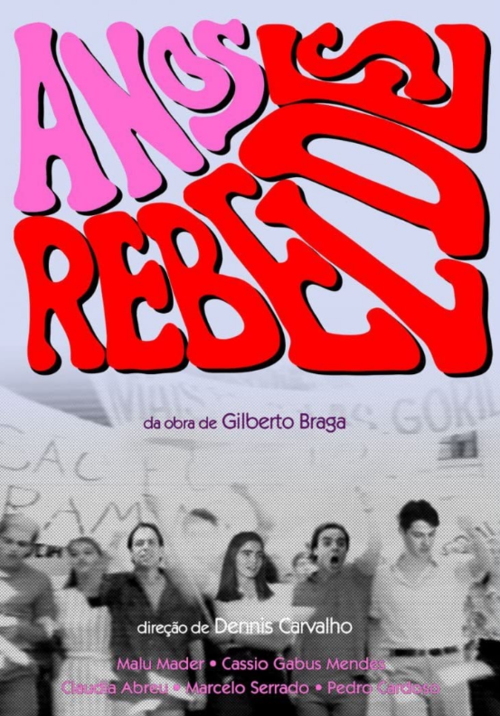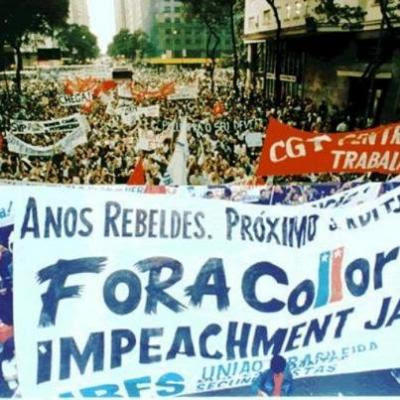Anos Rebeldes
Poster of the miniseries Anos Rebeldes
Caras Pintadas Movement at the demonstrations for the impeachment of President Fenando Collor de Melo
The 1992 miniseries Anos Rebeldes recounts the experiences of a group of teenagers from 1963 to 1979 who graduate from high school. It focuses on the love story between João Alfredo, an idealistic boy who joins the armed conflict, and Maria Lúcia, who prefers to be apolitical. The series shows how the Brazilian military dictatorship (1964-1985) affects the life of this group of young people and the other characters in the plot.
Gilberto Braga was inspired to write the miniseries by the books "1968, o ano que não terminou" (1988) by journalist Zuenir Ventura and ""Os Carbonários": memórias da guerrilha perdida" (1980) by Alfredo Syrkis. The young actors who form the dramatic core of the miniseries are juxtaposed with older actors of the 1967/70 generation who were also affected by the dictatorship. Director Dennis Carvalho had to watch Bete Mendes, his partner and actress in the miniseries, disappear during the dictatorship. It was the first time that political violence, torture, and censorship during the military dictatorship in Brazil were shown on public television. The series repeatedly shows "historical image panels" (port. painéis históricos), sequences of historical images and archival footage in black and white by Silvio Tendler. The innovation of the "historical picture panels" consists not only in the depiction of events of reality at decisive moments in historical time, but also in the composition of the melodramatic plot.
The miniseries builds a growing tension, accompanied by the timeline of the development of Brazilian society under the dictatorship. Through the "explanatory" debates between the characters about the different political positions that each of them adopts in the development of the "historical" reality, the political issues of the time are illuminated.
The miniseries had a decisive influence on the public demonstrations that called for the impeachment of President Fenando Collor de Melo in 1992. According to media reports, the miniseries inspired the "caras-pintadas" movement, as the young people are called who painted their faces when they went to the demonstrations of the popular movement "Fora Collor". An important aspect for GUMELAB is the influence of both events, which connect the history of Brazil in a cultural and political way.
Sources and references
ABDALA JUNIOR, R. Memórias da ditadura, TV e os 'rebeldes' anos 1980: um estudo sobre o papel da minissérie Anos Rebeldes na cultura histórica de brasileiros em1992. Goiânia, 2021. 2ª Edição.
ABDALA JUNIOR, Roberto. Brasil anos 1990: teleficção e ditadura — entre memórias e história. Topoi (Rio de Janeiro), v.13, p.94 - 111, 2012.
KORNIS, Mônica Almeida. Uma História do Brasil recente nas minisséries da Rede Globo. Escola de Comunicação e Artes da Universidade de São Paulo, novembro de 2000. Mimeo.
SKIDIMORE, Thomas. Brasil: de Castelo a Tancredo, 1964 a 1985. Trad. Mario Salviano Silva. Rio de Janeiro: Paz e Terra, 1988.
SYRKIS, Alfredo. “Os Carbonários” memórias da guerrilha perdida. Rio de Janeiro, Editora: Global, 1984. (5ª Edição).
VENTURA, Zuenir. 1968, o ano que não terminou. Rio de Janeiro: Nova Fronteira, 2003 [1988]. 39ª Impressão.
Wikipedia (2021): „Anos Rebeldes”. Available online at https://pt.wikipedia.org/wiki/Anos_Rebeldes. Last checked on 16.12.2021.
Wikipedia (2021): „Caras-pintadas“. Available online at https://pt.wikipedia.org/wiki/Caras-pintadas. Last checked on 16.12.2021.


